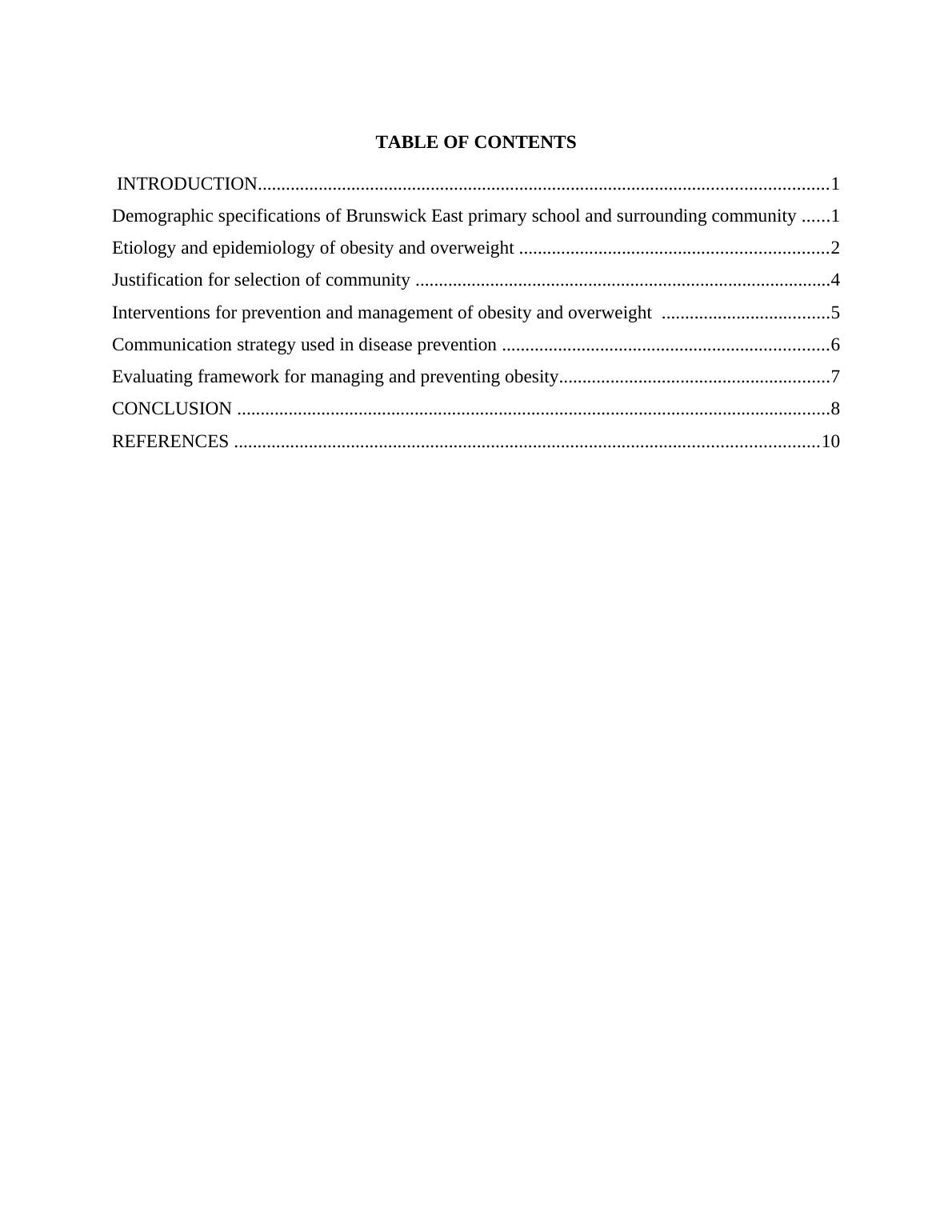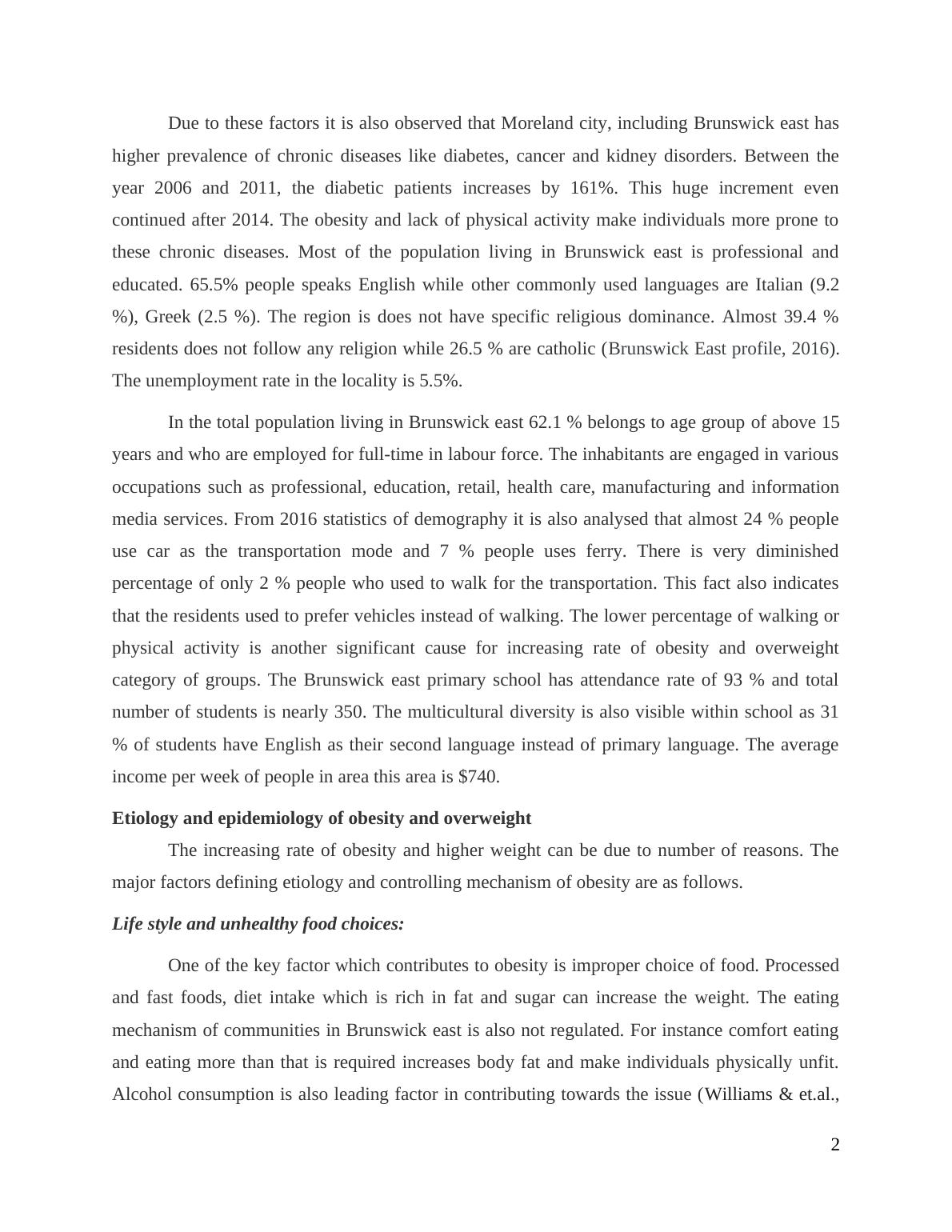Disease Prevention Subject Assignment Sample
Added on 2021-01-01
13 Pages3974 Words482 Views
Disease prevention subject

TABLE OF CONTENTS
INTRODUCTION..........................................................................................................................1
Demographic specifications of Brunswick East primary school and surrounding community ......1
Etiology and epidemiology of obesity and overweight ..................................................................2
Justification for selection of community .........................................................................................4
Interventions for prevention and management of obesity and overweight ....................................5
Communication strategy used in disease prevention ......................................................................6
Evaluating framework for managing and preventing obesity..........................................................7
CONCLUSION ...............................................................................................................................8
REFERENCES .............................................................................................................................10
INTRODUCTION..........................................................................................................................1
Demographic specifications of Brunswick East primary school and surrounding community ......1
Etiology and epidemiology of obesity and overweight ..................................................................2
Justification for selection of community .........................................................................................4
Interventions for prevention and management of obesity and overweight ....................................5
Communication strategy used in disease prevention ......................................................................6
Evaluating framework for managing and preventing obesity..........................................................7
CONCLUSION ...............................................................................................................................8
REFERENCES .............................................................................................................................10

INTRODUCTION
Non communicable diseases (NCD) are known as chronic diseases which are not
contagious and lasts for long duration of time. According to world health organisation around
71% of deaths all over the world are due to NCD (Noncommunicable diseases, 2018). Some of
the most common examples of NCD are obesity, Alzheimer, cancer, diabetes and cardiovascular
diseases. The report will role of disease management and prevention strategies in improving
community health. It will consider the analysis of Brunswick East primary school which is
situated in suburban area of Brunswick east, Australia.
The report will evaluate the demographic feature of school and its surrounding
community. It will also describe the epidemiology and etiology of obesity in community. The
document will outline the intervention and communication strategy for the issue mentioned
above. It will also provide an evaluation framework for achieving the objectives of disease
prevention.
Demographic specifications of Brunswick East primary school and surrounding
community
The school is situated in Brunswick East which is suburb of city of Moreland. According
to Census QuickStats (2016), the population of community in the region is around 11,504 and it
has 2696 families. In comparison to other suburb-profiles of Moreland city Brunswick east
regions has higher percentage of young people. Approx 53 % of the community is between the
age group of 20 to 38 years. The school is made environmentally sustainable by its joint efforts
with Moreland council. Special funds are also provided for disable children.
The majority of the population (62 %) is natural habitant of Australia while other
habitants are migrants from China, Italy, England and New Zealand. Mostly flat dwelling
structures are used in area but it also has separate house, semi-detached and row housing. NCD
are more vulnerable in people with obesity and overweight. According to Health and Wellbeing
Profile (2017), in 2012 the suburb observed increment in obesity among people. It resulted in 3
adults out of 5 to be more prone to chronic diseases due to weight imbalance. Though in 2014
the issue was controlled and there was a minor decline of 0.3% in number of obese people and
9.4 % decline in those of overweight category.
1
Non communicable diseases (NCD) are known as chronic diseases which are not
contagious and lasts for long duration of time. According to world health organisation around
71% of deaths all over the world are due to NCD (Noncommunicable diseases, 2018). Some of
the most common examples of NCD are obesity, Alzheimer, cancer, diabetes and cardiovascular
diseases. The report will role of disease management and prevention strategies in improving
community health. It will consider the analysis of Brunswick East primary school which is
situated in suburban area of Brunswick east, Australia.
The report will evaluate the demographic feature of school and its surrounding
community. It will also describe the epidemiology and etiology of obesity in community. The
document will outline the intervention and communication strategy for the issue mentioned
above. It will also provide an evaluation framework for achieving the objectives of disease
prevention.
Demographic specifications of Brunswick East primary school and surrounding
community
The school is situated in Brunswick East which is suburb of city of Moreland. According
to Census QuickStats (2016), the population of community in the region is around 11,504 and it
has 2696 families. In comparison to other suburb-profiles of Moreland city Brunswick east
regions has higher percentage of young people. Approx 53 % of the community is between the
age group of 20 to 38 years. The school is made environmentally sustainable by its joint efforts
with Moreland council. Special funds are also provided for disable children.
The majority of the population (62 %) is natural habitant of Australia while other
habitants are migrants from China, Italy, England and New Zealand. Mostly flat dwelling
structures are used in area but it also has separate house, semi-detached and row housing. NCD
are more vulnerable in people with obesity and overweight. According to Health and Wellbeing
Profile (2017), in 2012 the suburb observed increment in obesity among people. It resulted in 3
adults out of 5 to be more prone to chronic diseases due to weight imbalance. Though in 2014
the issue was controlled and there was a minor decline of 0.3% in number of obese people and
9.4 % decline in those of overweight category.
1

Due to these factors it is also observed that Moreland city, including Brunswick east has
higher prevalence of chronic diseases like diabetes, cancer and kidney disorders. Between the
year 2006 and 2011, the diabetic patients increases by 161%. This huge increment even
continued after 2014. The obesity and lack of physical activity make individuals more prone to
these chronic diseases. Most of the population living in Brunswick east is professional and
educated. 65.5% people speaks English while other commonly used languages are Italian (9.2
%), Greek (2.5 %). The region is does not have specific religious dominance. Almost 39.4 %
residents does not follow any religion while 26.5 % are catholic (Brunswick East profile, 2016).
The unemployment rate in the locality is 5.5%.
In the total population living in Brunswick east 62.1 % belongs to age group of above 15
years and who are employed for full-time in labour force. The inhabitants are engaged in various
occupations such as professional, education, retail, health care, manufacturing and information
media services. From 2016 statistics of demography it is also analysed that almost 24 % people
use car as the transportation mode and 7 % people uses ferry. There is very diminished
percentage of only 2 % people who used to walk for the transportation. This fact also indicates
that the residents used to prefer vehicles instead of walking. The lower percentage of walking or
physical activity is another significant cause for increasing rate of obesity and overweight
category of groups. The Brunswick east primary school has attendance rate of 93 % and total
number of students is nearly 350. The multicultural diversity is also visible within school as 31
% of students have English as their second language instead of primary language. The average
income per week of people in area this area is $740.
Etiology and epidemiology of obesity and overweight
The increasing rate of obesity and higher weight can be due to number of reasons. The
major factors defining etiology and controlling mechanism of obesity are as follows.
Life style and unhealthy food choices:
One of the key factor which contributes to obesity is improper choice of food. Processed
and fast foods, diet intake which is rich in fat and sugar can increase the weight. The eating
mechanism of communities in Brunswick east is also not regulated. For instance comfort eating
and eating more than that is required increases body fat and make individuals physically unfit.
Alcohol consumption is also leading factor in contributing towards the issue (Williams & et.al.,
2
higher prevalence of chronic diseases like diabetes, cancer and kidney disorders. Between the
year 2006 and 2011, the diabetic patients increases by 161%. This huge increment even
continued after 2014. The obesity and lack of physical activity make individuals more prone to
these chronic diseases. Most of the population living in Brunswick east is professional and
educated. 65.5% people speaks English while other commonly used languages are Italian (9.2
%), Greek (2.5 %). The region is does not have specific religious dominance. Almost 39.4 %
residents does not follow any religion while 26.5 % are catholic (Brunswick East profile, 2016).
The unemployment rate in the locality is 5.5%.
In the total population living in Brunswick east 62.1 % belongs to age group of above 15
years and who are employed for full-time in labour force. The inhabitants are engaged in various
occupations such as professional, education, retail, health care, manufacturing and information
media services. From 2016 statistics of demography it is also analysed that almost 24 % people
use car as the transportation mode and 7 % people uses ferry. There is very diminished
percentage of only 2 % people who used to walk for the transportation. This fact also indicates
that the residents used to prefer vehicles instead of walking. The lower percentage of walking or
physical activity is another significant cause for increasing rate of obesity and overweight
category of groups. The Brunswick east primary school has attendance rate of 93 % and total
number of students is nearly 350. The multicultural diversity is also visible within school as 31
% of students have English as their second language instead of primary language. The average
income per week of people in area this area is $740.
Etiology and epidemiology of obesity and overweight
The increasing rate of obesity and higher weight can be due to number of reasons. The
major factors defining etiology and controlling mechanism of obesity are as follows.
Life style and unhealthy food choices:
One of the key factor which contributes to obesity is improper choice of food. Processed
and fast foods, diet intake which is rich in fat and sugar can increase the weight. The eating
mechanism of communities in Brunswick east is also not regulated. For instance comfort eating
and eating more than that is required increases body fat and make individuals physically unfit.
Alcohol consumption is also leading factor in contributing towards the issue (Williams & et.al.,
2

End of preview
Want to access all the pages? Upload your documents or become a member.
Related Documents
PUBH631 Disease Prevention and Managementlg...
|15
|4070
|34
HEALTH CITIES AND URBAN COMMUNITIES.lg...
|23
|5511
|1
Primary Healthcare in Developing Countries: A Focus on Indialg...
|14
|4003
|392
Project Management Project Plan for Developing Health Care Homes Name of University Author's Note- Introductionlg...
|17
|3521
|444
Prevention of Obesitylg...
|11
|2917
|127
Issue of Obesity in Primary Health Care (Australia vs. the U.S.A)lg...
|9
|2422
|349
